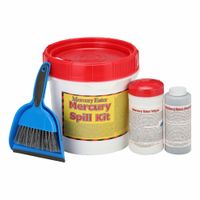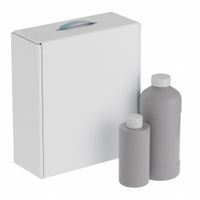Call +(254) 703 030 000 / 751 483 999 / 721 704 777
- Home
- Safety
- Sorbents Spill Control Spill Containment
- Sorbents Spill Kits
- Mercury Sorbents Spill Kits
.....Read More
Frequently Asked Questions
What is a mercury spill kit and what does it contain?
A mercury spill kit is a specialized set of tools and materials designed to safely clean up and contain mercury spills, typically from broken thermometers, barometers, or other devices containing mercury. Mercury is a toxic heavy metal that can pose significant health risks if not handled properly, so these kits are essential for ensuring safe cleanup procedures.
A typical mercury spill kit contains the following components:
1. **Protective Gear**: Includes gloves, goggles, and sometimes a mask or respirator to protect the user from mercury vapors and direct contact with the skin.
2. **Mercury Absorbent Powder**: A specialized powder that amalgamates with mercury, making it easier to collect and reducing vapor release.
3. **Mercury Vapor Suppressant**: A chemical agent that minimizes the release of mercury vapors during cleanup.
4. **Scoop and Scraper**: Tools for gathering mercury beads and contaminated materials.
5. **Syringe or Pipette**: Used to suction up small mercury beads from surfaces.
6. **Sealant or Tape**: For sealing off contaminated areas or securing broken devices to prevent further leakage.
7. **Disposal Containers**: Airtight containers for safely storing collected mercury and contaminated materials until they can be properly disposed of.
8. **Instruction Manual**: Detailed guidelines on how to safely and effectively use the kit components during a spill.
9. **Warning Labels**: To mark contaminated areas and alert others to the presence of mercury.
These kits are essential in laboratories, medical facilities, and any environment where mercury is used, ensuring that spills are managed safely and efficiently to protect human health and the environment.
How do mercury sorbents work in cleaning up spills?
Mercury sorbents work by adsorbing mercury from contaminated surfaces or environments, effectively reducing its presence and mitigating its harmful effects. These sorbents are typically composed of materials with high affinity for mercury, such as activated carbon, sulfur-impregnated compounds, or specialized polymers.
When applied to a mercury spill, the sorbent material interacts with the mercury through physical and chemical processes. The high surface area of the sorbent allows for maximum contact with mercury droplets or vapors. Chemical reactions may occur between the sorbent and mercury, forming stable compounds that are less volatile and easier to handle. For instance, sulfur-based sorbents react with mercury to form mercuric sulfide, a stable and insoluble compound.
The effectiveness of mercury sorbents depends on factors such as the type of sorbent used, the form of mercury present (elemental, ionic, or organic), and environmental conditions like temperature and humidity. Once the mercury is adsorbed, the sorbent can be collected and disposed of safely, often following specific hazardous waste protocols to prevent further contamination.
In summary, mercury sorbents clean up spills by adsorbing mercury through physical and chemical interactions, converting it into less harmful forms, and allowing for safe disposal.
What are the steps to safely clean up a mercury spill?
1. **Evacuate and Ventilate**: Immediately evacuate the area and ensure that pets and children are kept away. Open windows and doors to ventilate the space, but avoid using fans as they can spread mercury vapors.
2. **Protect Yourself**: Wear gloves, preferably nitrile or latex, to avoid direct contact with mercury. Use a mask to prevent inhalation of vapors.
3. **Contain the Spill**: Use cardboard or stiff paper to gently push the mercury beads together. Avoid using a vacuum cleaner or broom, as they can disperse mercury into the air.
4. **Collect Mercury**: Use an eyedropper or sticky tape to pick up the mercury beads. Place them in a sealable container. For small beads, use sticky tape to lift them from surfaces.
5. **Check for Residue**: Shine a flashlight at a low angle to spot any remaining mercury beads. Use sticky tape to collect any you find.
6. **Dispose of Contaminated Materials**: Place all materials used in the cleanup, including gloves and paper, in a sealable plastic bag. Label it as hazardous waste.
7. **Clean the Area**: Use a mercury spill kit if available, or sprinkle sulfur powder or zinc powder to bind any remaining mercury. Carefully clean the area with a damp paper towel and dispose of it in the hazardous waste bag.
8. **Seal and Store Waste**: Seal the waste bag and store it in a safe place away from living areas until it can be properly disposed of.
9. **Contact Authorities**: Reach out to local environmental or health authorities for guidance on proper disposal of mercury waste.
10. **Monitor Health**: Be aware of symptoms of mercury exposure, such as headaches or nausea, and seek medical attention if necessary.
How can mercury vapor suppressants help in spill situations?
Mercury vapor suppressants are chemical agents used to reduce the release and spread of mercury vapors during spill situations. When mercury is spilled, it can evaporate and release toxic vapors that pose significant health risks. Suppressants work by forming a barrier or reacting with mercury to limit vaporization.
1. **Barrier Formation**: Some suppressants create a physical barrier over the mercury spill. This barrier prevents mercury from evaporating into the air, thereby reducing the concentration of toxic vapors. The barrier can be a liquid or gel that encapsulates the mercury, effectively isolating it from the environment.
2. **Chemical Reaction**: Certain suppressants chemically react with mercury to form less volatile compounds. These reactions can convert mercury into a more stable form, such as a salt or amalgam, which does not easily vaporize. This transformation significantly decreases the amount of mercury vapor released into the air.
3. **Immediate Action**: Mercury vapor suppressants are typically fast-acting, providing immediate reduction in vapor levels. This rapid response is crucial in minimizing exposure to hazardous vapors, protecting both the environment and human health.
4. **Ease of Use**: These suppressants are often easy to apply, requiring minimal equipment or specialized training. This accessibility ensures that they can be quickly deployed in emergency situations, enhancing their effectiveness in spill management.
5. **Environmental and Health Protection**: By reducing mercury vapor emissions, suppressants help protect the health of individuals in the vicinity of the spill and prevent environmental contamination. This is particularly important in indoor settings where ventilation may be limited.
Overall, mercury vapor suppressants are a critical tool in managing mercury spills, providing an effective means to control vapor release and mitigate associated risks.
What tools are included in a mercury spill kit for effective cleanup?
A mercury spill kit typically includes the following tools for effective cleanup:
1. **Protective Gear**:
- Nitrile or latex gloves to prevent skin contact.
- Safety goggles to protect eyes from mercury vapors.
- Disposable shoe covers to avoid contamination.
2. **Mercury Absorbent Material**:
- Specially designed absorbent powder or sponges that amalgamate with mercury to make it easier to collect.
3. **Mercury Vapor Suppressant**:
- Chemicals or powders that suppress mercury vapors, reducing inhalation risks.
4. **Mercury Collection Tools**:
- A squeegee and dustpan to gather mercury beads.
- A small brush for collecting mercury from hard-to-reach areas.
- A suction device or syringe for picking up small mercury droplets.
5. **Sealable Containers**:
- Airtight plastic or glass containers for safely storing collected mercury and contaminated materials.
6. **Disposal Bags**:
- Heavy-duty, sealable plastic bags for disposing of contaminated items and cleanup materials.
7. **Indicator Strips**:
- Mercury detection strips to ensure all mercury has been collected and to check for residual contamination.
8. **Instruction Manual**:
- Detailed guidelines on how to safely and effectively use the kit and handle mercury spills.
9. **Warning Labels**:
- Labels to mark contaminated areas and materials for proper disposal.
10. **Emergency Contact Information**:
- Contact details for local environmental or health authorities for further assistance if needed.
These tools collectively ensure that mercury spills are managed safely, minimizing health risks and environmental impact.
How do you properly dispose of mercury waste after a spill?
1. **Evacuate and Ventilate**: Immediately evacuate the area and ensure it is well-ventilated by opening windows and doors to disperse mercury vapors.
2. **Protect Yourself**: Wear protective gloves, goggles, and a mask to prevent direct contact and inhalation of mercury vapors.
3. **Contain the Spill**: Use cardboard or stiff paper to carefully gather mercury beads. Avoid using a vacuum cleaner or broom, as they can spread mercury vapors.
4. **Use Adhesive Tape**: For small beads, use duct tape or sticky tape to pick them up. Place the tape in a sealed plastic bag.
5. **Use a Mercury Spill Kit**: If available, use a mercury spill kit to clean up the spill. These kits often contain absorbent powders and specialized tools for mercury collection.
6. **Double-Bag the Waste**: Place all collected mercury, contaminated materials, and cleanup tools in a sealable plastic bag. Double-bagging is recommended to prevent leaks.
7. **Label the Waste**: Clearly label the bags as "Mercury Waste" to ensure proper handling and disposal.
8. **Contact Local Authorities**: Reach out to local environmental or health authorities for guidance on disposal. Mercury is hazardous waste and must be disposed of according to local regulations.
9. **Do Not Pour Down Drains**: Never dispose of mercury waste in sinks, toilets, or drains, as it can contaminate water systems.
10. **Professional Cleanup**: For large spills or if unsure, contact a professional hazardous waste disposal service to handle the cleanup and disposal.
11. **Monitor for Residual Mercury**: After cleanup, monitor the area for any remaining mercury using a mercury vapor analyzer if available.
What safety precautions should be taken when handling mercury spills?
1. **Evacuate the Area**: Immediately clear the area of people and pets to prevent exposure.
2. **Ventilation**: Open windows and doors to ventilate the area, ensuring that mercury vapors do not accumulate.
3. **Protective Gear**: Wear gloves, goggles, and a mask to prevent direct contact and inhalation of mercury vapors.
4. **Contain the Spill**: Use a squeegee or cardboard to gather mercury beads. Avoid using a vacuum cleaner or broom, as they can spread mercury vapors.
5. **Use a Mercury Spill Kit**: If available, use a mercury spill kit that includes absorbent powder, sponges, and disposal bags specifically designed for mercury.
6. **Collect Mercury**: Use sticky tape or duct tape to pick up small beads. A flashlight can help locate hidden beads by reflecting light off the mercury.
7. **Double-Bagging**: Place collected mercury and contaminated materials in a sealable plastic bag, then double-bag it for added security.
8. **Label and Store**: Clearly label the bag as hazardous waste and store it in a secure area away from living spaces.
9. **Contact Authorities**: Notify local environmental or health authorities for proper disposal instructions.
10. **Avoid Contaminated Items**: Do not wash contaminated clothing or items in a washing machine, as this can spread mercury.
11. **Monitor Symptoms**: Be aware of symptoms of mercury exposure, such as tremors, insomnia, or memory problems, and seek medical attention if they occur.
12. **Professional Cleanup**: For large spills or if unsure, contact a professional hazardous materials cleanup service.
13. **Prevent Future Spills**: Store mercury-containing items securely and handle them with care to prevent future incidents.


